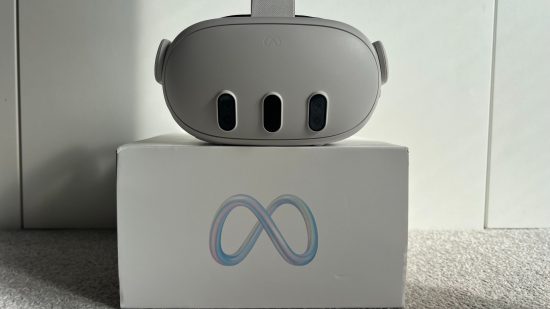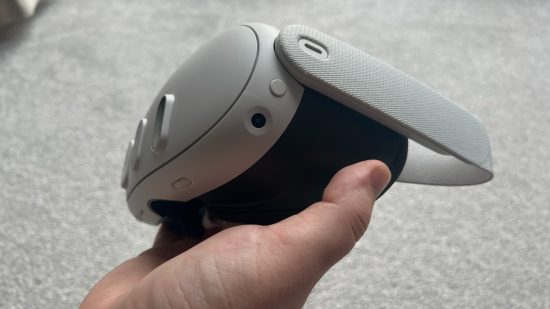Our Verdict
A huge leap forward in technology is only held back by basic comfort issues that require an additional cost to fix, and a lack of native software on day one. Meta are playing the long game with the Quest 3, and this is a headset that's capable of bringing VR gaming to the masses.
- Mixed reality is no gimmick
- Touch Plus controllers are a massive upgrade
- The new form factor is better for anyone with glasses
- The included head strap is the least comfortable on the market
- More expensive than the Quest 2’s launch price
- No dedicated Quest 3 games available at launch
The Meta Quest 3 arrived on the scene accompanied by big promises and a bigger price tag. As it now hits store shelves, I can confidently say that Meta has delivered on many of its key statements, proving that, while VR gaming is still yet to hit its peak, a golden age appears to be just on the horizon.
However, does the Meta Quest 3 push enough boundaries to be considered one of the best VR headsets ever? Quite comfortably, yes. In my time testing Meta’s new flagship VR product, it is clear the company has found many ways to push the Meta Quest 3 far beyond the boundaries of the Quest 2. That being said, there are still some generational issues that remain unaddressed and can’t be overlooked.
Specs
| Meta Quest 3 specs | |
| CPU | Snapdragon XR2 Gen 2 |
| DRAM | 8GB |
| Display | 2064×2208 per eye, pancake lens |
| Refresh Rate | 90Hz / 120Hz |
| FOV | 110 degrees horizontal / 96 degrees vertical |
| Battery | 3 hours |
| Weight | 515g |
| Storage | 128GB or 512GB |
Design and comfort
I need to kick off this review of the Meta Quest 3 by highlighting the biggest issue I have with the headset: comfort. Unfortunately, it simply isn’t comfortable to wear for long sessions with issues arising as early as ten minutes into wearing, depending on the intensity of the game I was playing. My biggest gripe with previous iterations of the Quest was that you had to upgrade to the elite strap, or a third-party alternative, for a less fatiguing fit and this is somehow still the case with the Meta Quest 3. This a very common complaint with the Quest headsets and it’s quite surprising, but also disappointing, to see that Meta is yet to address it.
On a much more positive note, the Quest 3’s overall design has targeted many of the right aspects to offer an upgrade. The headset is now 40% slimmer, although this is offset slightly as the headset is no lighter than the Quest 2. Even though the weight stays similar, there is the illusion of a lighter feel because the headset sits much closer to the face, offering a better center of gravity, so I never felt like my head was being pulled forward.
As a glasses wearer, the new solution for creating space within the headset is a dream. Rather than having to use an awkward spacer, you can now simply extend and retract the distance between the face guard and the lenses using a slider on each side of the facial interface. Even after continuously playing around with these settings, I find that the setting out of the box is the best for me, but I am confident anyone should be able to easily find the perfect fit.
The move away from the old silicon facial interface to a padded fabric alternative is hugely welcome. While I am sure it costs more in manufacturing, it provides a massive generational improvement and Meta made the right call to make this adjustment. It also offers a new way to customize the Quest, as you can purchase various colored straps and interfaces, with Elemental Blue and Blood Orange being the official options at launch. For what it’s worth, I’m very much a fan of the Blood Orange strap as it creates a nice contrast when compared to the neutral tone of the headset.
The new passthrough color cameras give the Meta Quest 3 a unique look in comparison to its predecessors, and it’s something I rate quite highly and a great way to easily distinguish between models for those who may be unfamiliar with VR headsets. Passthrough is a new feature that allows for a more true-to-life view of your surroundings when not actively playing a game. It also plays a massive role in mixed reality experiences. In place of the dull, monochromatic feed that the Quest 2 has, this new view is far more relaxing and is a great way to quickly take a break if I do ever start to struggle with nausea.
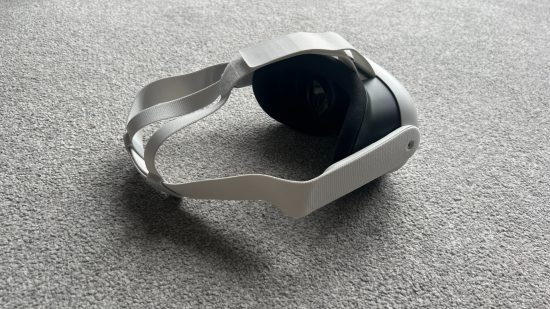
Performance and battery life
Meta Quest 3’s performance is unequivocally leaps and bound ahead of the 2. This is evident from running older unoptimized games on Quest 3 and noticing a distinct difference in loading time and frame rate stability. If this is what Meta Quest 3 does to games without any input from the developer, you can only imagine how fully optimized titles like The Walking Dead: Saints and Sinners and Red Matter 2 have been improved. It’s like taking off your glasses, cleaning the dirt, and suddenly being able to see into a whole new dimension.
It is a shame that no bespoke Quest 3 experiences are available at launch outside of some tester apps, but I’m excited to see how the likes of Assassin’s Creed Nexus and Asgard’s Wrath 2 turn out. I expect that both of them will set the benchmark for performance and visual quality for years to come. Optimized games will be a treat, no doubt, but ground-up experiences are where Quest 3 will shine, although Meta will perhaps not want to abandon Quest 2 users so soon. There is a compromise available in adding performance modes for the Quest 3, but there are already signs that the game file sizes might be fixed, meaning Quest 2 owners can’t avoid downloading the larger APKs, thus taking up more space than they want.
Mixed reality also presents a great opportunity for the Meta Quest 3. The new passthrough cameras allow you to use your actual environment as a game world, best seen in the upcoming release of Ghostbusters: Rise of the Ghost Lord, where you’ll be eradicating Mini-Pufts in a dedicated mixed reality game mode. More and more games will adopt mixed reality for specific game modes, but I’m most excited to see full game releases that hone in on this exciting opportunity moving forward.
Quest 3’s overall performance increase comes courtesy of the Snapdragon XR2 Gen 2 processor, which Meta claims doubles the power of the Quest 2. Beyond this, a substantial lens upgrade sees the Quest 3 make the move to pancake lenses, just like the Quest Pro, operating at 2064×2208 per eye with a 120Hz refresh rate. These are two major factors in the reduced feeling of nausea during intense action games or general prolonged use.
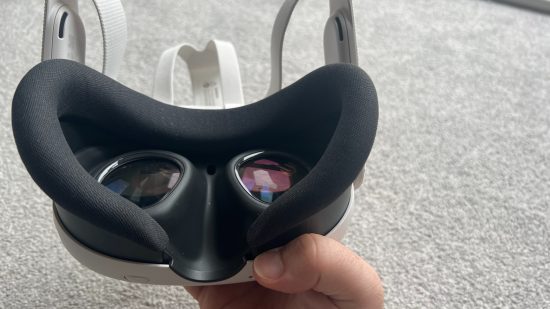
Improved specs are always a great way to justify a premium price, but it’s understanding how these specs unlock a whole new level of potential that is crucial. VR gaming has come a long way in a short space of time, and the Quest headsets are a prime example of this. Thinking back to how VR or AR gaming was first introduced to the mainstream, it revolved around taking a device you already owned such as a mobile phone, and placing it into a shoddily produced headset to let you try out games that qualified only as gimmicks and nothing more. As we moved towards the first few iterations of purpose-built gaming VR headsets, these devices allegedly caused horrific nausea after very little play time, another huge obstacle that the Quest 3 has now broken down entirely.
Now, there’s no PC or console involved, and everything you need is in the headset itself. Games will grow with the technology and 30+ hour experiences are a real possibility. Provided that the bigger developers in the industry buy-in – and some already have – VR gaming could be heading for a huge peak.
The Touch Plus controllers are a huge leap forward when it comes to immersion. Removing the halo from each controller prevents awkward bumping together in-game, and they feel far more accurate and responsive, much like the Touch Pro controllers. They also now support wireless charging, which is great if you invest in a charging stand, but I relied on AA batteries throughout my testing, and they’re barely drained after a solid week of play. In addition to the better controllers, hand-tracking accuracy has also improved. Experiences like Elixir are a great showcase of these improvements, and I found myself happily turning to hand-tracking in certain games where I’ve previously been too attached to controllers for fear of tracking issues.
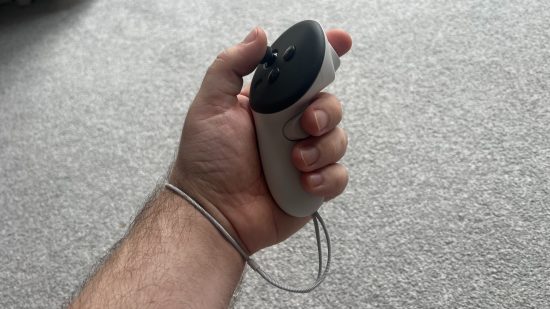
As for the battery life of Meta Quest 3, I had hoped it would be a little better. In our testing, we drained the battery in just over three hours with games constantly running. Like the issue with the head strap, finding a new strap that comes with a chargeable battery pack included will be key here. With all this said, I understand some uncomfortable comprises likely would have been needed to improve playtime in addition to all the spec upgrades.
With the stronger performance enabling longer sessions, thanks to smoother frame rates and generally better image quality, battery life will become a major factor if it deteriorates too quickly. The long-term battery life simply isn’t something we can test at this moment in time, but a small accessory, like a charging pack, can prevent you from having to try and navigate using the Quest 3 while actively charging it from an outlet.
Price and where to buy
The Meta Quest 3 128GB model costs $499.99 / £479.99, while the 512GB version sets you back $649.99 / £619.99. Many VR games have a smaller install size compared to modern PC games, but some can tip the scales at close to 10GB.
Having spent our time with the 512GB model, it’s safe to say we might never need to uninstall any games which is a nice luxury to have, it’s just whether it’s worth paying an extra $150 for. However, game files could be set to increase with the Quest 3 optimization patches, which could see file sizes inflate.
Still, you may be better served sticking with the 128GB model and using that extra cash to upgrade to the Elite strap, or a third-party alternative, to secure your comfort and allow for longer play sessions with the battery pack.
The Meta Quest 3 can be purchased directly from the Meta store or online retailers including Amazon, Best Buy, Target, and Gamestop.
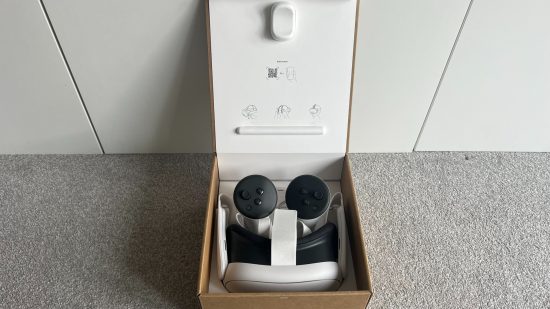
Should you buy the Meta Quest 3?
The Meta Quest 3 is easily the best way to get started with VR. A high price tag may understandably push some away, but it’s truly a steal despite its cost. A lot of energy has gone into making the Quest 3 a comfortable experience physically on your head, but it has failed with its inclusion of a very basic strap which is known to be a problem from the Quest 2.
However, the improved visual quality and the effect this has on my ability to play for longer was a massive improvement, one that shows there is still plenty to come from the VR industry. With a fantastic suite of existing software, even with no native Quest 3 games coming until the end of the year, now really is the best time to jump into VR.
I highly recommend the Meta Quest 3, with the caveat that you will need to upgrade or change your head strap for added comfort, this is a small change that will transform your time with the headset hugely.
Verdict
The Meta Quest 3 is a clear step up in every aspect, apart from comfort, compared to its predecessor. As a long-time VR enthusiast, it feels like we’re reaching new heights in the industry, but developer support is going to be key to turning this potential into reality. The lack of games built for the system and poor head strap can’t be ignored, but everything else the Meta Quest 3 brings to the table is a step in the right direction.
